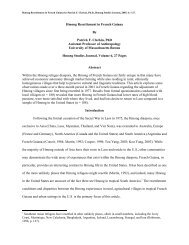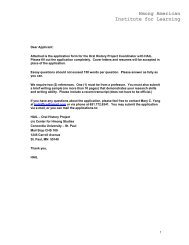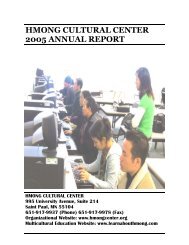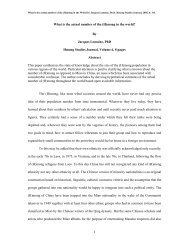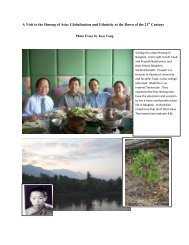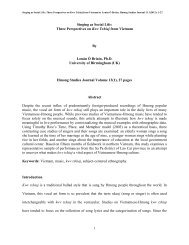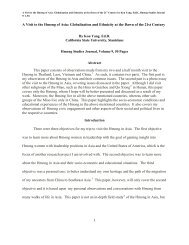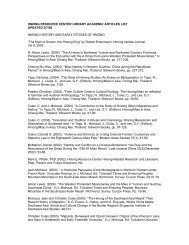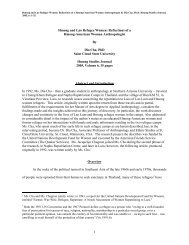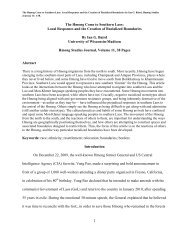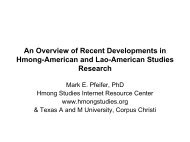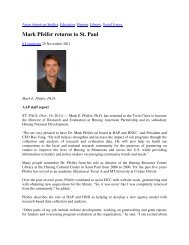Research Notes from the Field - Hmong Studies Internet Resource ...
Research Notes from the Field - Hmong Studies Internet Resource ...
Research Notes from the Field - Hmong Studies Internet Resource ...
Create successful ePaper yourself
Turn your PDF publications into a flip-book with our unique Google optimized e-Paper software.
<strong>Research</strong> <strong>Notes</strong> <strong>from</strong> <strong>the</strong> <strong>Field</strong>:Tracing <strong>the</strong> Path of <strong>the</strong> Ancestors – A Visit to <strong>the</strong> <strong>Hmong</strong> in China by Kou Yang, EdD,<br />
<strong>Hmong</strong> <strong>Studies</strong> Journal, 2005, 6: 1-38.<br />
The Miao in China<br />
The Miao are <strong>the</strong> fifth largest of <strong>the</strong> fifty-six Chinese nationalities, following <strong>the</strong> Han, Zhuang,<br />
Manchu, and Hui. The term minority in this paper is defined as “a subordinate group whose members have<br />
significantly less control or power over <strong>the</strong>ir own lives than do members of a dominant or <strong>the</strong> majority group”<br />
(Schaefer, 2000: 6). There are four major groups that are lumped under <strong>the</strong> name, Miao, and <strong>the</strong>y are<br />
Goshiong/Guoxiong, Hmu, Ah Hmao, and <strong>Hmong</strong>. According to Gu Wenfeng, Chinese linguists classify <strong>the</strong><br />
Miao into three major language groups: Eastern or Western Hunan, Central or Eastern Guizhou, and Western<br />
or <strong>the</strong> Sichuan, Guizhou and Yunnan languages. What follows are discussions of each one of <strong>the</strong> four major<br />
groups.<br />
The Goshiong or Guoxiong is probably <strong>the</strong> most educated and economically stable of <strong>the</strong> o<strong>the</strong>r Miao<br />
subgroups. They live mostly in Hunan province. Song Zhuying, one of <strong>the</strong> most well-known Chinese singers,<br />
is <strong>from</strong> Hunan and a member of <strong>the</strong> Goshiong subgroup. Song Zhuying is one of <strong>the</strong> most recognized faces in<br />
today’s China as she sings patriotic songs in almost every major national event in China. Wu Xiaoping, who<br />
has visited <strong>the</strong> <strong>Hmong</strong> in <strong>the</strong> United States many times, is also <strong>from</strong> Hunan. In general, Qoshiong or<br />
Guoxiong speak in <strong>the</strong> eastern or western Hunan branch, and <strong>the</strong> central branch of <strong>the</strong> Miao language.<br />
In <strong>the</strong> past, Chinese documents distinguished between <strong>the</strong> cooked and raw Miao. For example,<br />
Chinese literature <strong>from</strong> <strong>the</strong> Qing Dynasty refers to raw Miao as those Miao who live in western Hunan. Gu<br />
Wenfeng suggested that <strong>the</strong> cooked Miao had been mostly assimilated. For example, <strong>the</strong>re are many villages<br />
in Mayang County in <strong>the</strong> Hunan Province, who call <strong>the</strong>mselves “Miao”, but retain few aspects of <strong>the</strong> Miao<br />
culture and language. Quincy (1995:16) describes <strong>the</strong> cooked Miao as those “who had assimilated into<br />
Chinese culture and settled in <strong>the</strong> lowlands, and were living among <strong>the</strong> Chinese. The raw <strong>Hmong</strong> [Miao] live<br />
up in <strong>the</strong> mountains and had never accepted Chinese ways.” Although Hebei has only a small population of<br />
Miao, one of its Vice-Governors is a Miao. Long Zhunagwei, a Vice-Governor of Hebei, is a Miao and native<br />
of Enshi Prefecture, Hubei Province.<br />
The Hmu live mostly in sou<strong>the</strong>ast Guizhou in <strong>the</strong> Qiandongnan Miao and Dong Prefecture. They<br />
have well known and admired costumes. Professors Li Jinping, who belongs to <strong>the</strong> Hmu, explained to <strong>the</strong><br />
group during his lecture about Miao history that silver ornaments of <strong>the</strong> Hmu can cost up to three thousand<br />
US dollars or more. Many Hmu girls wear <strong>the</strong> silver buffalo horns during <strong>the</strong>ir major festivities. Many of<br />
today’s leaders in Guizhou, such as Wang Chaowen, <strong>the</strong> former Governor of Guizhou, are Hmu. Generally,<br />
<strong>the</strong> Hmu speak <strong>the</strong> Central or Eastern Guizhou branch of <strong>the</strong> Miao language family.




